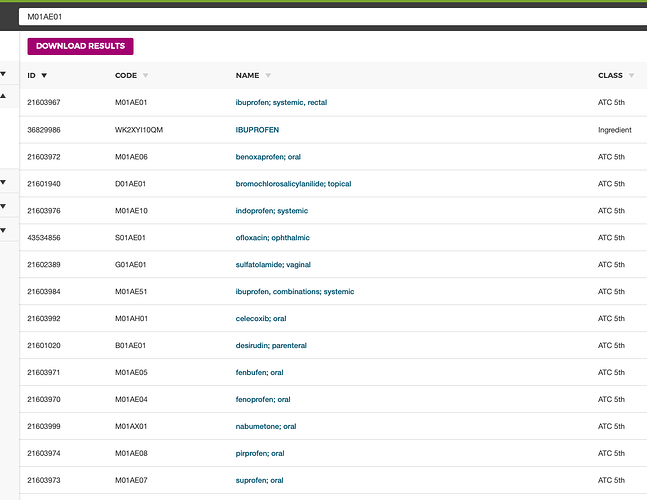In the current vocab assessed through Athena I see that there are routes added in the concept names of ATC codes:
I can see that this may be useful for some use cases but it then needs to be correct or I suggest to completely remove the route.
For example “M01AE01 Ibuprofen; systemic, rectal” how is this concept name created? Is this done by OHDSI in some way? This ATC code has multiple routes including Oral. Why is rectal selected here as label only? What is the QA procedure on this concept name creation? Where is the code that does this to check?
Thanks.
Added Fully automated AI Generated Report with some examples:
OMOP vs WHO ATC Route Discrepancy Analysis for M01A Drugs
Summary
Analysis reveals systematic errors in OMOP ATC concept naming where parenteral routes are consistently omitted despite being officially included in WHO ATC/DDD definitions.
Detailed Comparison Table
| ATC Code | Drug Name | OMOP Concept Name | WHO Official Routes | Explicitly Named Routes | Missing from Name | Issue? |
|---|---|---|---|---|---|---|
| M01AE01 | Ibuprofen | “ibuprofen; systemic, rectal” | O, P, R | Only R (rectal) | O (Oral), P (Parenteral) | |
| M01AB05 | Diclofenac | “diclofenac; systemic, rectal” | O, P, R | Only R (rectal) | O (Oral), P (Parenteral) | |
| M01AE03 | Ketoprofen | “ketoprofen; systemic, rectal” | O, P, R | Only R (rectal) | O (Oral), P (Parenteral) | |
| M01AE02 | Naproxen | “naproxen; oral, rectal” | O, R | O (oral), R (rectal) | None | |
| M01AB01 | Indometacin | “indometacin; systemic, rectal” | O, P, R | Only R (rectal) | O (Oral), P (Parenteral) | |
| M01AB02 | Sulindac | “sulindac; systemic, rectal” | O, R | Only R (rectal) | O (Oral) | |
| M01AC01 | Piroxicam | “piroxicam; systemic, rectal” | O, P, R | Only R (rectal) | O (Oral), P (Parenteral) | |
| M01AC06 | Meloxicam | “meloxicam; systemic, rectal” | O, P, R | Only R (rectal) | O (Oral), P (Parenteral) | |
| M01AE09 | Flurbiprofen | “flurbiprofen; oral, rectal” | O, R | O (oral), R (rectal) | None | |
| M01AC02 | Tenoxicam | “tenoxicam; systemic, rectal” | O, P, R | Only R (rectal) | O (Oral), P (Parenteral) | |
| M01AC05 | Lornoxicam | “lornoxicam; systemic, rectal” | O, P, R | Only R (rectal) | O (Oral), P (Parenteral) |
Route Abbreviations
- O = Oral
- P = Parenteral (IV/IM/SC)
- R = Rectal
Key Findings
1. The “Systemic” Problem is Universal
- ALL drugs using “systemic, rectal” naming have the same problem as M01AE01
- 9 out of 11 drugs (82%) have incorrect OMOP concept names
- “Systemic” obscures specific routes - users cannot tell which systemic routes are included
Issue Severity Levels:
- SEVERE: Missing 2+ explicitly named routes (oral AND parenteral hidden behind “systemic”)
- MODERATE: Missing 1 explicitly named route (oral hidden behind “systemic”)
2. Inconsistent Terminology
- Some drugs correctly use “oral, rectal” when only O,R routes exist
- Others incorrectly use “systemic, rectal” when parenteral routes exist but are omitted
3. M01AE01 (Ibuprofen) - Most Problematic
- OMOP concept name: “ibuprofen; systemic, rectal”
- WHO official routes: O, P, R (Oral, Parenteral, Rectal)
- The name only explicitly mentions rectal
- “Systemic” is ambiguous and doesn’t clearly indicate oral or parenteral routes
- This is the most misleading concept name as it obscures two of the three official routes
Impact Assessment
 Correctly Named Concepts (Only 2!)
Correctly Named Concepts (Only 2!)
- M01AE02 (Naproxen): “naproxen; oral, rectal” explicitly names both WHO routes “O,R”
- M01AE09 (Flurbiprofen): “flurbiprofen; oral, rectal” explicitly names both WHO routes “O,R”
 Incorrectly Named Concepts (9 drugs!)
Incorrectly Named Concepts (9 drugs!)
SEVERE Issues (7 drugs) - Missing explicit mention of 2 routes:
- M01AE01 (Ibuprofen): “systemic” hides oral + parenteral routes
- M01AB05 (Diclofenac): “systemic” hides oral + parenteral routes
- M01AE03 (Ketoprofen): “systemic” hides oral + parenteral routes
- M01AB01 (Indometacin): “systemic” hides oral + parenteral routes
- M01AC01 (Piroxicam): “systemic” hides oral + parenteral routes
- M01AC06 (Meloxicam): “systemic” hides oral + parenteral routes
- M01AC02 (Tenoxicam): “systemic” hides oral + parenteral routes
- M01AC05 (Lornoxicam): “systemic” hides oral + parenteral routes
MODERATE Issue (1 drug) - Missing explicit mention of 1 route:
- M01AB02 (Sulindac): “systemic” hides oral route
Recommended Corrections
All drugs currently using “systemic, rectal” should have explicit route naming:
| Current OMOP Name | Should Be |
|---|---|
| “ibuprofen; systemic, rectal” | “ibuprofen; oral, parenteral, rectal” |
| “diclofenac; systemic, rectal” | “diclofenac; oral, parenteral, rectal” |
| “ketoprofen; systemic, rectal” | “ketoprofen; oral, parenteral, rectal” |
| “indometacin; systemic, rectal” | “indometacin; oral, parenteral, rectal” |
| “piroxicam; systemic, rectal” | “piroxicam; oral, parenteral, rectal” |
| “meloxicam; systemic, rectal” | “meloxicam; oral, parenteral, rectal” |
| “tenoxicam; systemic, rectal” | “tenoxicam; oral, parenteral, rectal” |
| “lornoxicam; systemic, rectal” | “lornoxicam; oral, parenteral, rectal” |
| “sulindac; systemic, rectal” | “sulindac; oral, rectal” |
Conclusion
This analysis reveals a critical data quality issue in the OHDSI OMOP vocabulary where 82% of analyzed ATC concept names use ambiguous terminology that obscures official WHO routes. The systematic use of “systemic” instead of explicit route naming creates misleading concept names that could significantly impact:
- Drug utilization studies
- Clinical decision support systems
- Pharmacovigilance analyses
- Healthcare analytics relying on accurate route information
Recommendation: OHDSI vocabulary team should review and correct these concept names to ensure alignment with authoritative WHO ATC/DDD definitions.
